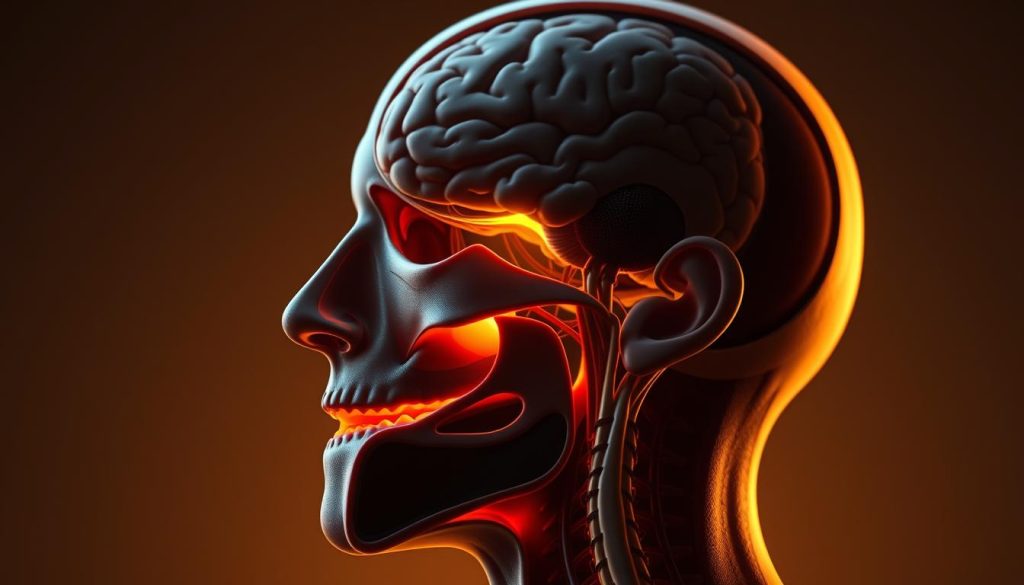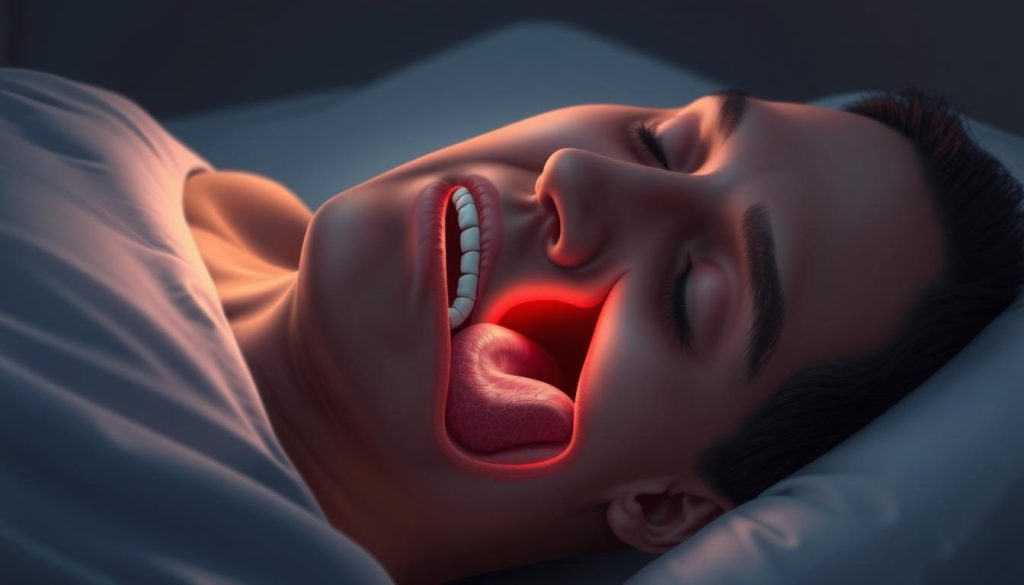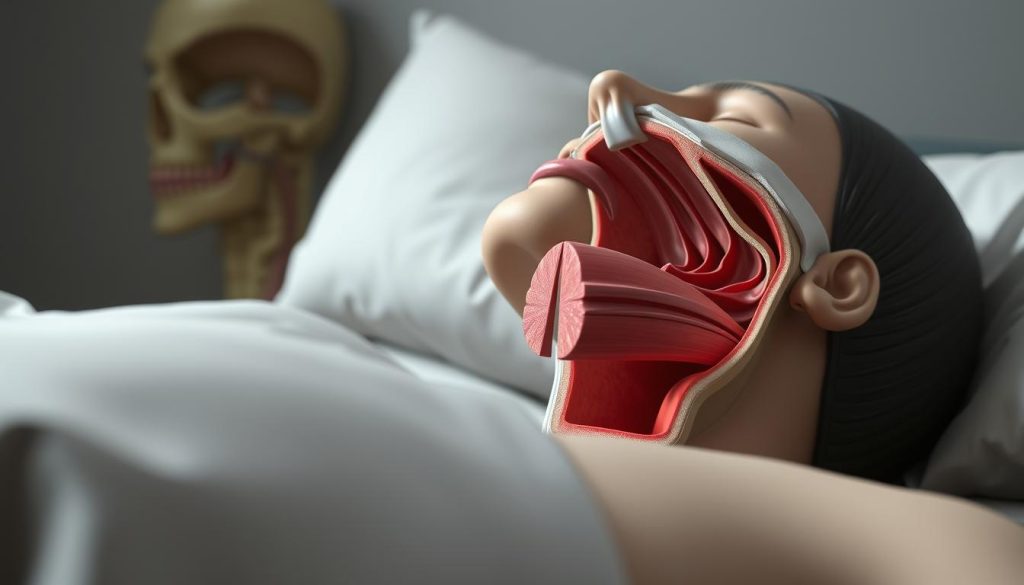Sleep apnea is a common condition that affects millions of people in the United States. It occurs when breathing repeatedly stops and starts during rest, leading to disrupted sleep and other health issues. If left untreated, this condition can increase the risk of serious complications, including heart problems and chronic fatigue.
Understanding the different forms of this condition is crucial for effective management. Early identification can help reduce risks and improve overall quality of life. Many people experience symptoms like loud snoring or daytime drowsiness but may not realize they have sleep apnea.
This guide will walk you through the key aspects of this condition, from symptoms to treatment options. By the end, you’ll have a clearer picture of how to address it and take steps toward better health.
Introduction to Sleep Apnea and Its Impact
Breathing disruptions at night can signal a condition known as sleep apnea. This issue occurs when a person’s breathing repeatedly stops and starts during rest. These interruptions can last for seconds or even minutes, leading to poor sleep quality and other health concerns.
The brain plays a crucial role in regulating breathing patterns. When this process is disrupted, it can cause a person to wake up briefly, often without realizing it. Over time, these disruptions can take a toll on overall health, increasing the risk of heart problems, fatigue, and other complications.
Understanding your sleep patterns is essential for identifying early warning signs. Common symptoms include loud snoring, daytime drowsiness, and morning headaches. Recognizing these signs can help you seek timely treatment and improve your quality of life.
While there are different forms of this condition, all of them affect a person’s health in significant ways. Undiagnosed cases can lead to long-term risks, making early detection critical. By addressing the issue promptly, you can reduce its impact and enjoy better rest.
| Key Aspect | Details |
|---|---|
| Breathing Interruptions | Pauses in breathing during sleep, often unnoticed. |
| Brain’s Role | Controls breathing patterns; disruptions can cause awakenings. |
| Common Symptoms | Loud snoring, daytime fatigue, morning headaches. |
| Health Risks | Increased risk of heart issues, chronic fatigue, and more. |
What is Sleep Apnea?
Sleep apnea is a condition where breathing stops intermittently during rest. These pauses can occur multiple times an hour, leading to fragmented sleep. The brain’s inability to maintain consistent breathing patterns is often the root cause.
Importance of Understanding Your Sleep
Being aware of your sleep habits can help you spot early symptoms. If you notice frequent snoring or feel tired despite a full night’s rest, it might be time to consult a specialist. Early diagnosis can prevent long-term health issues and improve your overall well-being.
Understanding the Types of Sleep Apnea
Many people experience breathing issues at night without knowing the underlying cause. These disruptions can stem from different forms of sleep-related disorders, each with unique characteristics and treatment needs. Identifying the specific type is crucial for effective management and improved health.

Obstructive Sleep Apnea Explained
Obstructive sleep apnea is the most common form, affecting millions of people. It occurs when the airway becomes blocked, often by the tongue or soft palate. This blockage prevents proper airflow, leading to repeated pauses in breathing during rest.
Common symptoms include loud snoring, gasping for air, and daytime fatigue. Studies show that untreated obstructive sleep apnea can increase the risk of heart disease and other serious health issues. Early diagnosis and treatment are essential for reducing these risks.
Central and Complex Sleep Apnea Overview
Central sleep apnea is less common and involves the brain’s inability to send proper breathing signals. Unlike obstructive sleep apnea, there is no physical blockage. Instead, the issue lies in the neurological control of breathing.
Complex sleep apnea combines elements of both obstructive and central sleep apnea. This condition often requires specialized treatment, as it involves both airway blockages and neurological factors. Accurate diagnosis is key to tailoring the right approach for each individual.
Understanding the differences between these forms helps in seeking appropriate care. Whether it’s obstructive, central, or complex sleep apnea, timely intervention can lead to better sleep and improved overall health.
Recognizing the Symptoms and Risk Factors
Daytime fatigue and loud snoring are often overlooked but can signal underlying issues. These symptoms, along with others, may point to breathing disruptions during rest. Understanding these signs and their associated risk factors is essential for early intervention and better health.

Identifying Common Warning Signs
Frequent snoring, excessive sleepiness, and breathing interruptions are key indicators. These symptoms occur when the airway becomes partially or fully blocked, reducing airflow. Pressure changes in the airway during rest can worsen these issues, leading to fragmented sleep.
Morning headaches and irritability are also common. These signs often result from the body’s struggle to maintain consistent oxygen levels. If you notice these symptoms persisting, it’s important to consult a healthcare professional.
Understanding the Role of Age, Weight, and Gender
Certain factors increase the likelihood of experiencing breathing disruptions. Age plays a role, as muscle tone in the airway tends to decrease over time. Excess weight can also contribute, as it puts additional pressure on the airway.
Gender is another factor, with studies showing a higher prevalence among men. However, women, especially post-menopause, are also at risk. Recognizing these factors can help in identifying and addressing the issue early.
By paying attention to persistent symptoms and understanding risk factors, you can take proactive steps toward better health. Early diagnosis and treatment are key to improving sleep quality and overall well-being.
Exploring the Causes and Underlying Mechanisms
Understanding the root causes of breathing disruptions during rest can help in addressing the issue effectively. These interruptions often stem from physical blockages or neurological factors, each contributing to the problem in unique ways. Identifying the specific cause is essential for tailored treatment and improved health.

Physical Obstructions in the Airway
One of the primary causes of breathing disruptions is a blocked airway. This often happens when the tongue relaxes during rest, falling back and obstructing the air passage. Excess tissue in the throat can also narrow the upper airway, making it harder to breathe.
Weight plays a significant role in this process. Excess fat around the neck and throat can put pressure on the airway, further reducing airflow. Lowered oxygen levels during rest can lead to frequent awakenings, even if the person doesn’t fully realize it.
Reduced muscle tone during rest can also contribute to airway collapse. As muscles relax, they may fail to keep the airway open, causing breathing pauses. Addressing these physical factors is crucial for restoring normal airflow and improving rest quality.
Neurological Factors and Other Causes
Neurological conditions can disrupt the brain’s ability to regulate breathing. In some cases, the brain fails to send proper signals to the muscles that control respiration. This can lead to pauses in breathing, even without a physical blockage.
Certain medical conditions, such as heart failure or stroke, can also affect breathing patterns. These issues often require specialized treatment to address the underlying cause. Understanding the role of neurological factors helps in developing a comprehensive treatment plan.
By exploring both physical and neurological causes, individuals can better understand their condition. Early intervention and targeted treatment can lead to significant improvements in rest quality and overall health.
Diagnosis and Treatment Options for a Better Night’s Sleep
Effective management of breathing disruptions starts with accurate diagnosis and tailored treatment. Identifying the root cause of nighttime breathing issues is the first step toward better rest. Proper diagnosis and treatment can significantly improve sleep quality and overall health.
Sleep Studies and Diagnostic Procedures
Diagnosing breathing disruptions often involves sleep studies. These tests monitor your breathing, heart rate, and oxygen levels during rest. At-home test kits are also available, making it easier to gather data in a comfortable environment.
One key measurement is the apnea-hypopnea index (AHI). This metric calculates the number of breathing pauses per hour of sleep. A higher AHI indicates a more severe condition, helping specialists determine the appropriate treatment level.
Medical Interventions and Lifestyle Changes
Treatment options vary depending on the severity of the condition. CPAP machines are a common solution, using positive airway pressure to keep the airway open during rest. These devices are highly effective in reducing breathing pauses and improving sleep quality.
Other medical interventions include oral appliances and surgical procedures. Oral appliances reposition the jaw to prevent airway blockages, while surgery may remove excess tissue causing obstructions.
Lifestyle changes also play a crucial role. Weight loss, regular exercise, and positional therapy can significantly reduce symptoms. For example, sleeping on your side instead of your back can help keep the airway open.
| Diagnostic Procedure | Details |
|---|---|
| Sleep Studies | Monitor breathing, heart rate, and oxygen levels during rest. |
| At-Home Test Kits | Convenient option for gathering sleep data in a familiar environment. |
| Apnea-Hypopnea Index (AHI) | Measures the number of breathing pauses per hour to determine severity. |
| Treatment Option | Details |
|---|---|
| CPAP Machines | Use positive airway pressure to keep the airway open during rest. |
| Oral Appliances | Reposition the jaw to prevent airway blockages. |
| Surgical Procedures | Remove excess tissue causing obstructions in the airway. |
| Lifestyle Changes | Include weight loss, exercise, and positional therapy for symptom reduction. |
By addressing the issue with the right treatment, you can reduce daytime sleepiness and enjoy better rest. Early intervention and consistent care are key to improving your overall health and well-being.
Managing Sleep Apnea with Lifestyle and Device Choices
Managing breathing disruptions during rest requires a combination of devices and lifestyle adjustments. Recent research highlights that long-term improvement often involves both medical tools and healthy habits. By addressing the issue from multiple angles, individuals can achieve better rest and overall health.
Positive Airway Pressure Devices and Alternatives
CPAP machines are a common option for managing breathing issues. These devices use positive airway pressure to keep the airway open during rest. They are highly effective in reducing interruptions and improving sleep quality.
For those who find CPAP uncomfortable, alternative devices like oral appliances are available. These tools reposition the jaw to prevent blockages, offering a more comfortable option for some users. Consulting a specialist can help determine the best choice for your needs.
Weight Management, Exercise, and Daily Habits
Lifestyle changes play a crucial role in long-term management. Weight loss and regular exercise can reduce pressure on the airway, making it easier to breathe during rest. Even small changes, like sleeping on your side, can have a significant impact.
Establishing a consistent sleep pattern is also essential. Going to bed and waking up at the same time each day helps regulate your body’s internal clock. This routine promotes better rest and reduces the likelihood of breathing disruptions.
By combining devices with healthy habits, individuals can experience noticeable improvements in rest quality. Ongoing management and monitoring ensure sustained benefits, leading to better overall health.
Achieving Enhanced Sleep Quality and Overall Health
Taking control of your nighttime breathing can transform your health and well-being. Proper management of breathing disruptions reduces stress on the heart and helps maintain optimal blood health. Maintaining consistent airway pressure throughout the night ensures your throat stays open, improving airflow and rest quality.
Improved rest lowers the risk of chronic conditions like heart disease. Establishing a healthy sleep form and routine can make a significant difference. Research and success stories highlight the benefits of proactive management, from better energy levels to enhanced overall health.
If you suspect symptoms like snoring or daytime fatigue, seek professional advice. Addressing the issue early can lead to lasting improvements in your health and quality of life.

